The landscape of Computational Fluid Dynamics (CFD) software has changed dramatically over the last few decades. In the past, CFD was expensive, CPU-hungry proprietary software that required comprehensive training to be used effectively. This restricted the use of CFD to large organisations that had the resources to fully fund and integrate this type of software.
Nowadays, however, high-performance computing, open-source licensing models and the cloud have made CFD much more accessible. Companies can scale their simulations and run multiple cases simultaneously on unlimited cores at a much lower price. At the same time, advances in solver capabilities, turbulence models and automatic meshing have made CFD results more robust and accurate.
This shift in versatility has allowed CFD to be adopted by many more companies and industries. A recent report estimated that the global market of CFD in 2022 was $2 billion, which is set to grow by 8.3%, reaching $3.8 billion in 2030. In comparison, the market for cloud-based CFD will grow by 9.4% and be worth $2.4 billion in 2030 [1].
As more companies continue to exploit the capabilities of CFD, the potential applications of this software are increasing exponentially. CFD is now used to analyse the flow of blood through the heart, design more effective ventilation systems and even optimise the launch systems of rocket boosters.
Research Details
To better understand how organisations are currently utilising CFD, ENGYS decided to conduct a survey on the CFD technology trends in the global industry. The survey consisted of 15 questions and was sent out to a variety of engineering organisations and promoted on social media. The survey was answered by 104 professionals from over 12 industries, including Healthcare, Defence, Aerospace, Automotive, Energy, Marine and Chemical.
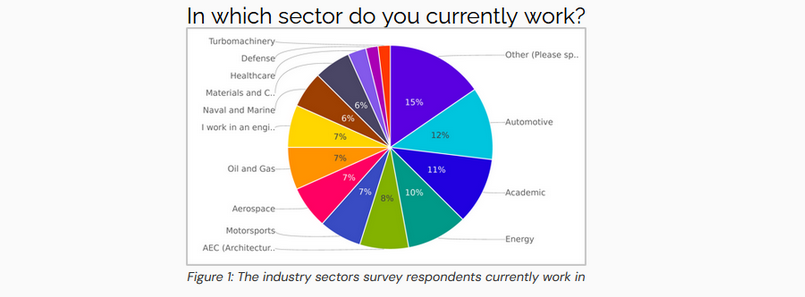
Current Usage of CFD Simulation Tools
Around 90% of survey respondents work for organisations that use CFD in some capacity, with the majority of those organisations managing their CFD processes in-house. Interestingly, only 5% outsource all their CFD practices, highlighting how accessible and usable CFD software has become.
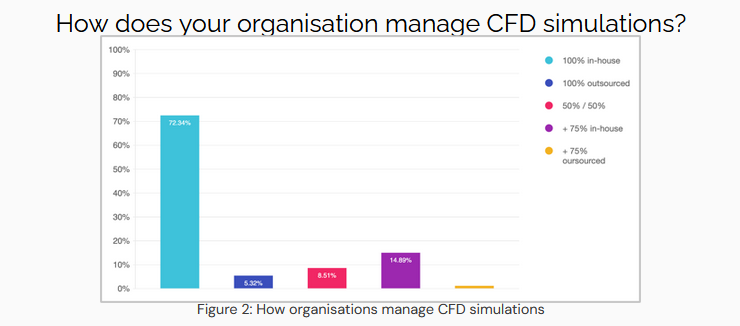
As more companies buy into the value CFD can bring to their industry, the demand for higher complexity and faster runtimes has continued to increase. This requires more cores, which is expensive with the conventional closed-source software license models. Furthermore, if companies want to run multiple cases at the same time with the traditional closed-source CFD software, they have to purchase additional licenses, escalating costs further.
This has prompted a shift towards open-source CFD software, allowing companies to run cases simultaneously on unlimited cores at much lower costs. The popularity of open-source CFD was reflected in survey responses, with 50% of the professionals using OpenFOAM in their organization.
The next most popular platforms were proprietary closed-source software’s ANSYS Fluent and STAR CCM+, while the second most popular open source software was ENGYS’s HELYX which is used by 26% of respondents.
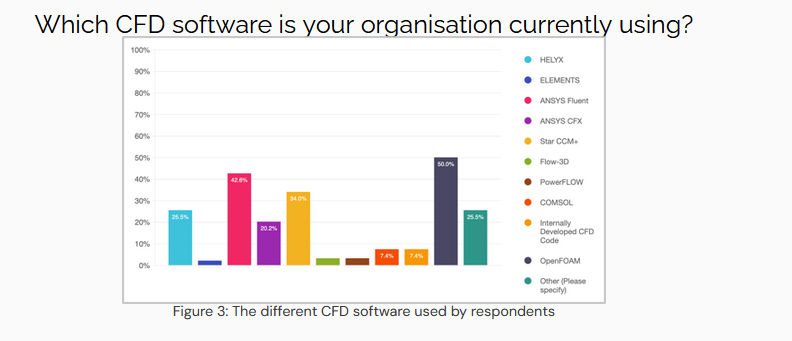
The replies regarding the duration of a typical CFD project were mostly split between weeks (36.2%), months (22.3%) and continuous CFD projects (24.5%). This variety is likely due to the differing simulation requirements of the various industries represented in this study. With respect to CPU cores count, most professionals are running on 12-48 cores, followed by 4-12 cores (20.2%), 128-512 cores (19.1%) and 48-128 cores (18.1%). With a deeper analysis of the survey responses, it is possible to notice that 66.34% of professionals running on more than 128 cores are using open source software. This is expected due to the unlimited scalability nature of CFD open source tools.
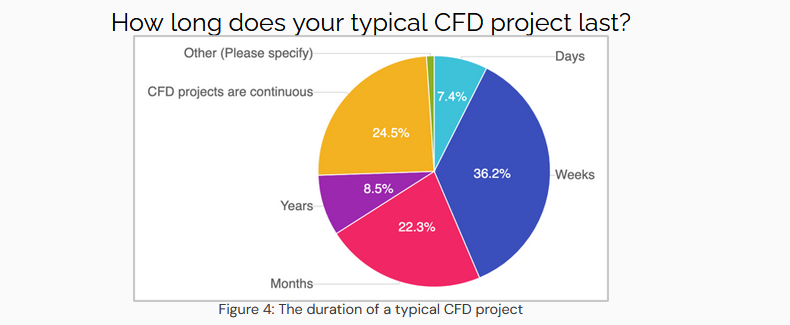
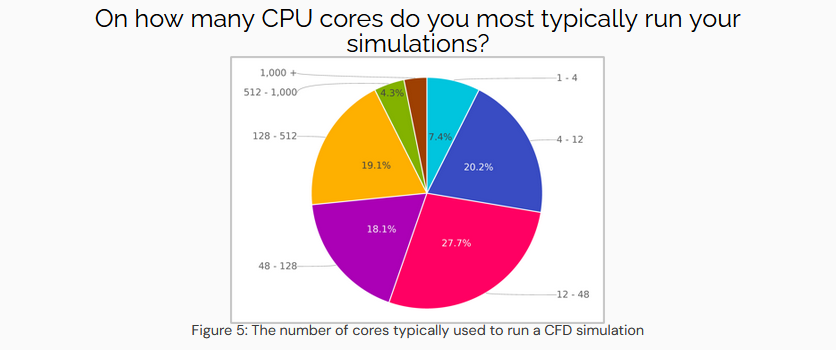
Current CFD Simulation Changes
Despite the incredible advances the CFD industry has made over the last few decades, adopting and utilising a CFD software package effectively can still present some challenges. When asked what they would like to improve in CFD software, most respondents said the simulations’ robustness. This was closely followed by mesh capabilities, accuracy and the price performance of CFD licenses.
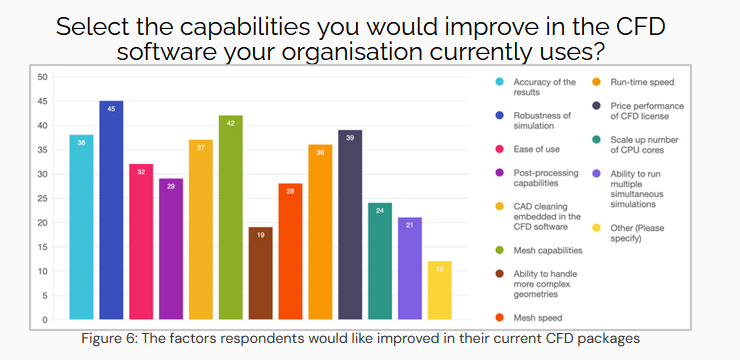
Setting up a complex CFD simulation can take anywhere between hours to weeks and even months, depending on the CFD software used. To help streamline this set-up phase, CFD vendors have focussed much of their recent development on standardising this process. Some provide CFD simulation templates that pre-define mesh and solver settings according to the type of case. Others use defeaturing techniques which automatically prepare the CAD model to be compatible with CFD solvers, saving the user time as they no longer have to manually fix the model.
However, preparing a model still remains the biggest challenge when running a CFD simulation, with 44% of respondents saying that easier model preparation would significantly help them in their CFD projects.
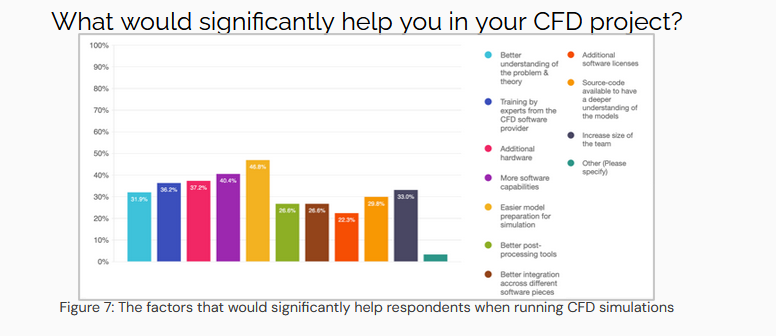
The cost of CFD licenses is a recurring theme throughout the survey. Of the respondents who do not currently use CFD, 50% said the price of CFD licenses was the main reason why their organisation does not use CFD.
It seems that cost is also a barrier to companies switching to new CFD software. The survey asked respondents to rank several factors on a scale of 0 to 5, where 1 is the most challenging and 5 is the least challenging. Budget constraints was ranked as the most challenging factor with a score of 2, yet the least challenging factor was organisations believing that there is a better option, which scored 3.4. This suggests that companies are aware of the benefits of other CFD software packages, but the costs are too high to warrant the investment.
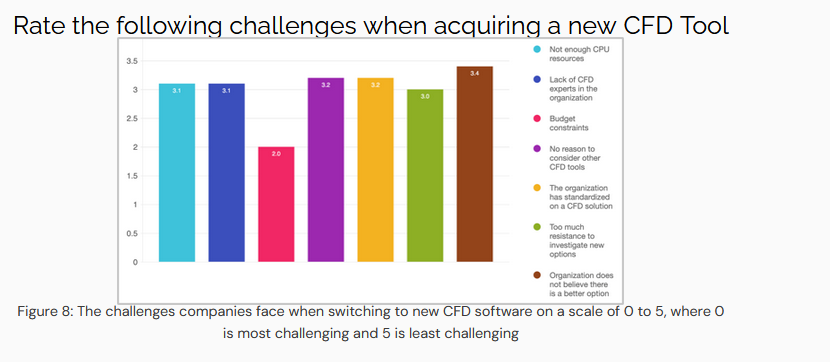
However, despite the cost of simulation, physical testing can often be three to five times more expensive. The levels of accuracy and reliability now possible with today’s software means that CFD can help rule out extreme scenarios and prioritise which physical tests are required, reducing overall testing time and cost.
This is confirmed by 61% of responses that state the main justification for companies choosing to invest in simulation is to reduce the cost of physical testing.
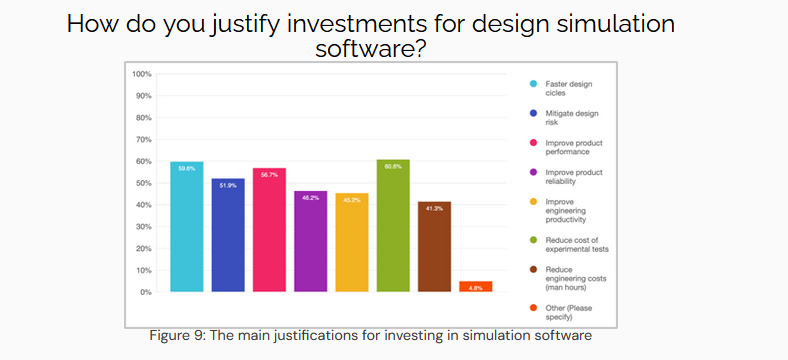
CFD On The Cloud
Cloud computing delivers computing services over the internet, providing on-demand access to resources without the need for on-premises hardware. Its scalability, flexibility, and cost-effectiveness have made it popular in various industries, including engineering.
The survey shows that 59% of the professionals have not accessed high-performance computing resources on the cloud, suggesting that there is still room for growth in the adoption of cloud computing for CFD analysis. There are several factors that barrier the use of cloud computing, which may include concerns regarding data security and privacy, impact speed and performance due to network latency and bandwidth limitations, and lead to significant costs for companies with large and frequent simulation requirements. However, it’s also clear that technology is evolving fast, and it will become safer and more cost-effective with time.
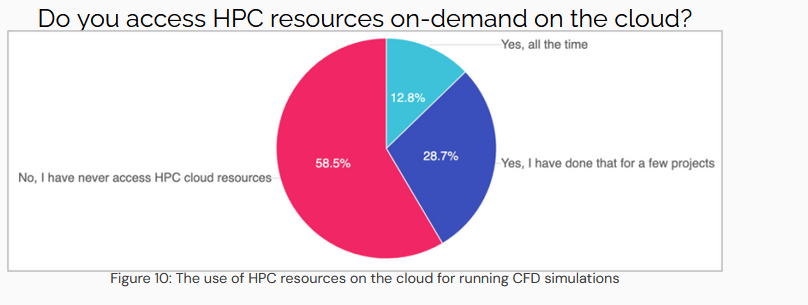
Conclusion
The use of CFD will continue to grow until 2030 and so too will the number of industries that CFD can provide value to. However, the cost of CFD licenses remains a barrier to companies adopting CFD into their development cycles and prevents existing CFD users from switching to new software.
This has led to open source software becoming more popular as it is highly customizable, cost-effective regarding licensing costs, and more versatile regarding cloud-based simulations. It is the combination of open source software and high-performance cloud computing that is the holy grail and allows users to run as many simulations as they want, at whatever complexity they require. However, as this survey suggests, more than half of companies have yet to run CFD simulations on the cloud. This highlights a need for more flexible and user-friendly cloud-based platforms that allow users to focus on utilising the results, rather than running the simulation.
Statistical Highlights
- 61% responded that reducing the cost of physical testing is the main justification for investing in simulation
- 72% manage all their CFD simulations in-house
- 50% of respondents use OpenFOAM in their organizations
References
[1] Computational Fluid Dynamics (CFD): Global Strategic Business Report [Online]. 2023. Global Industry Analysts Inc.


